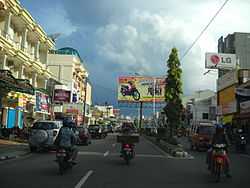Bangka–Belitung Islands
| Bangka–Belitung Islands Province Provinsi Kepulauan Bangka Belitung | |||
|---|---|---|---|
| Province | |||
 | |||
| |||
|
Motto: Serumpun Sebalai (Malay) (The same root, the same place) | |||
 | |||
| Coordinates: 2°8′S 106°7′E / 2.133°S 106.117°ECoordinates: 2°8′S 106°7′E / 2.133°S 106.117°E | |||
| Country | Indonesia | ||
| Capital | Pangkal Pinang | ||
| Government | |||
| • Governor | Rustam Effendi | ||
| Area | |||
| • Total | 16,424.14 km2 (6,341.40 sq mi) | ||
| Population [1] | |||
| • Total | 1,223,048 | ||
| • Density | 74/km2 (190/sq mi) | ||
| Demographics | |||
| • Ethnic groups | Malays (72%), Chinese (12%), Javanese (6%), Buginese (3%), Madurese (1%), Sundanese (1%) | ||
| • Religion | Muslim (82%), Buddhist (4.24%), Confucianism (3.25%), Protestantism (1.8%), Roman Catholicism (1.2%), Hindu (0.09%)[2] | ||
| • Languages | Indonesian, Malay, Hakka (Chinese) | ||
| Time zone | WIB (UTC+7) | ||
| Website | www.babelprov.go.id | ||
The Bangka–Belitung Islands (Indonesian: Kepulauan Bangka Belitung) is a province of Indonesia. Lying off Sumatra, the province comprises two main islands, Bangka and Belitung, and several smaller ones. In 2010 its population was 1,223,048.[1] The capital is Pangkal Pinang.
The Bangka Strait separates Sumatra and Bangka, and the Gaspar Strait separates Bangka and Belitung. The South China Sea is to the north, the Java Sea is to the south, and the province is separated from Borneo in the east by the Karimata Strait.
History
The first Chinese workers who came to Indonesia were mainly men. They began assimilating with local people and intermarriages followed, residents coexisting peacefully in spite of differences in religion and ethnicity. When anti-Chinese riots occurred in some parts of Indonesia in 1998 at the end of the Soeharto regime, local people and those of Chinese descent lived peacefully in the Bangka Belitung province.[3]
The province was formerly part of South Sumatra, but became a separate province along with Banten and Gorontalo in 2000.
Economy
These islands are the largest producer of tin in Indonesia. white pepper is also produced.
Health
According to the Indonesian Health Department, Bangka Belitung is highly malarious area. The annual malaria incidence rate in Bangka Belitung is reported as 29.3/1000 population.[4]
Administrative divisions
Bangka-Belitung is divided into six regencies and one city, below with their (provisional) populations at the 2010 Census.
| Name | Area (km2) | Population Estimate 2005 | Population Census 2010 | Capital |
|---|---|---|---|---|
| Pangkal Pinang (city) | 118.80 | 145,945 | 174,838 | Pangkal Pinang |
| Bangka Regency | 2,950.69 | 246,579 | 277,193 | Sungailiat |
| West Bangka Regency (Bangka Barat) | 2,820.61 | 147,855 | 175,110 | Muntok |
| South Bangka Regency (Bangka Selatan) | 3,607.08 | 148,912 | 172,476 | Toboali |
| Central Bangka Regency (Bangka Tengah) | 2,126.36 | 133,380 | 161,075 | Koba |
| Total Bangka | 11,623.54 | 822,671 | 960,692 | |
| Belitung Regency | 2,293.69 | 132,777 | 155,925 | Tanjung Pandan |
| East Belitung Regency (Belitung Timur) | 2,506.91 | 87,380 | 106,432 | Manggar |
| Total Belitung | 4,800.60 | 220,157 | 262,357 |
Tourism
Bangka Belitung Islands have many beaches and smaller islands with beaches having blue sea waters, coral reefs, white sand, and giant granite rock formations which have attracted tourists from around the world. The most well known beaches in Bangka Island are Matras, Parai, Tanjung Pesona, Batu Bedaun, Remodong, Pasir Padi, Tanjung Kelian, Rebo, and Telok Uber Beach. Whereas Belitung Island beaches are Tanjung Kiras Beach, Tanjung Pendam Beach, Tanjung Tinggi Beach, Tanjung Kelayang Beach, Tanjung Binga fisherman village Beach, Panyaeran Beach, Tanjung kubu Beach, Gembira Bay and Tanjung Ru Beach, which are the sites for diving, scuba, snorkeling, fishing and sailing.[5]
References
- ↑ 1.0 1.1 Central Bureau of Statistics: Census 2010, retrieved 17 January 2011 (Indonesian)
- ↑ Indonesia - Population by Region and Religion
- ↑ "Heaven on earth in Bangka Belitung". February 8, 2012.
- ↑ Indonesia Health Map 2007, Department of Health, Government of Indonesia.
- ↑ http://www.antaranews.com/en/news/71131/swb-2011-to-become-biggest-international-marine-event
Further reading
- Somers Heidhues, Mary F.(1992)Bangka tin and Mentok pepper : Chinese settlement on an Indonesian island Singapore : Social Isuues in Southeast Asia, Institute of Southeast Asian Studies. ISBN 981-3035-99-4
| |||||||||||||||||||||
| |||||||||||||||||||||||

